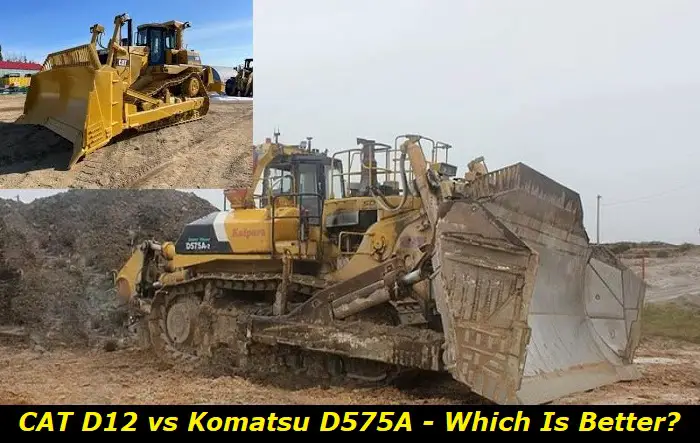Komatsu D575A vs Caterpillar D12: Common Issues and Durability
The Komatsu D575A and the Caterpillar D11 are arguably the largest crawler tractors in the market today. The two giants compete favorably both in size and operational capabilities. However, although, the Komatsu D575A's gigantic size and operational volume have made the crawler the undisputed champion among the crawler tractors, the Caterpillar D11 is not far behind.

Size Comparisons
The Komatsu super crawler tractor is identified with the letter D, which stands for Dozer and is then followed by a model number (for example 575A), the series number (-2 or -3), and the engine configuration (SD or SR).
The Komatsu D575A is a 12-cylinder super-sized crawler whose height is over 16 feet high (4.9 meters), that is, ten feet more than the height of an average, or, two-and-a-half 6-foot men put on top of each other. It is 38.4 feet (11.71 meters) long, 24.2 feet wide (with a standard blade), and comes along with a 2.4 feet (0.74) ground clearance. It weighs an astonishing 336, 420 pounds (152, 660 kg).
Other Komatsu D575A specifications include:
- Engine- 794.2 KW(1,065 Horsepower) and has two dedicated updates, the Komatsu D575A- 3SD, called the Super Dozer, and the Komatsu D575A-Bulldozer, commonly called the Ripper.
- 11 feet, 22,000pounds patented Super Dozer Blade
- Dig or carry a load capacity of 12 feet (3.6 meters) high, and 24 feet (7.4 meters) wide; equivalent to 90 cubic yards or 69 cubic meters).
- Optional semi-U or U- dozer blade both having either a single tilt or dual tilt cylinders. The optional blades have 44.5 cubic yards (34 M3) and 58.8 cubic yards (45 M3) capacity respectively.
- Contact area- over 100 square feet (9.4 square meters), exerting about 23 pounds per square inch of ground pressure, amounting to over 160 kPa of pressure.
Its rival, the Caterpillar D12 tractor is slightly shorter in height by three feet (it is 13.25 feet tall), and its blade capacity has a shortfall of over 15 cubic yards (its blade capacity is 74.9 cubic yards). The Caterpillar D12 has an engine displacement of 1959 cubic inches and 850 HP. It comes with comfortable and easy-to-control electro-hydraulic features, and an operator detection component that locks the system when the operator is entering or disembarking from the dozer.
The Caterpillar D12 has an Automatic Blade Assist feature (ABA), and a hydro-dynamic component that multiplies efficiency output by sending 25% of torque to the drive shaft directly and the remaining 75% through the converter.
Apart from these small size differences, the two massive tractors are designed to work in the mining and quarrying industries and all related environments to increase efficiency and operational capacities. For instance, the Komatsu D575A tractor increased the previous yard-per-hour operations from 375 yards to over 750 yards when it was introduced.
Common issues for Komatsu D575A and the Caterpillar D12
1) Oil leaks
Oil and the oil system are among the most critical components in these dozers. The hydraulic systems of the Komatsu D575A and the Caterpillar D12 rely on oil to transfer power from one point to the other. Apart from this, oil is used as a coolant for all transmissions, cylinders, and all other components. However, oil leaks are a common problem that leads to the malfunctioning of the dozers. Though oil leaks may be caused by worn-out rings or gaskets, a build-up of dirt in the drain plug may occasion such leakages. The drain plug should be cleaned regularly to cushion this common problem.
2) Bulldozer is unable to move
Crawler tractors usually develop a problem where they cannot move forwards or backward as expected. The bulldozer may move only for a short distance or fail to move at all. The issues usually emanate from the hydrostatic drive pump which could have issues with either the pump itself or the drive motor. This problem can be identified by checking the oil and the hydraulic filter. If there seem to be metallic pieces or other forms of debris in the filter, it is an indicator that the drive pump is faulty. It requires immediate attention to bring the bulldozer back to its operational state.
3) Bulldozer failing to turn on
The gigantic dozers tend to fail to start the morning after the night shift, after having been stopped normally. If the bulldozer fails to turn on, it may be a problem related to electrical faults, switches, solenoids, failed batteries, or an issue with the fuel systems. Any of these electrical faults may prevent the tractor from starting. It must be checked, identified, and rectified.
At times the same problem keeps recurring since these heavy machines use a single-wire system with a negative grounding. This is a deliberate move to make the line easy to maintain and repair the line. However, it also makes the line to be easily overloaded and causes electrical issues in the related components.
On the other hand, a clogged fuel system may prevent the dozer from starting. Due to the harsh environments where the dozers work daily, the fuel system lines, filters, and fuel tanks may get clogged with dirt and sediments. Clean the entire system and clean or replace the oil filter. To avoid a repeat of the problem, always ensure to clean the fuel system daily
4) Faulty hydraulic pins
Pins that lock hydraulic cylinders may become worn out over time due to their continuous contact with the cylinders. When the pins are worn out or broken, the hydraulic cylinders are not secured properly. The pins (piston and rod) should be replaced if they are too rusty, worn out, or broken.
5) Broken/cracked seals
Broken seals cause oil leakages and interfere with the proper operations of the hydraulic systems. The seals can cause bushes to crack and break, especially in cold weather. The breakage of the seals is caused by the harsh and extreme conditions exposed to the dozers. As such, the wearing out may be slow and unnoticed until the dozer suffers a major fault or component failure.
6) Track problems
Sometimes, due to continuous strenuous work, the engine gets extremely hot forcing the trackside to stop working. This problem is usually related to the steering clutches. Normally, steering clutches work in unison, with each releasing when the other on the opposite side is engaged. When the engine becomes hot, the clutches get worn out quickly and fail to release for the tracks to move. The problem can be rectified by replacing the worn-out clutches.
7) Faulty ECM
The ECM, Electronic Engine Control Modules of these dozers are programmed to control and monitor data output and functionality of the dozers. They contain a vast network of sensors to control and monitor every single function of the crawlers. They are located on the cooler parts of the engine since the dozer engines generate massive heat which could damage the ECM. The ECM contains both calibration and diagnostic parameters that perform very complex applications within split-second time frames.
The ECM can easily get damaged and faulty as a result of exposure to very high engine temperatures, dusty working environments, and water contamination. Usually, the ECM gives a "no injector pulse", or "lost data" message when faulty. Most of the time, the faults are a result of some component failure. ECM fault could be caused by:
- Defective sensors
- Engine vibrations that cause it to malfunction
- Exposure to dust and other dirt
- Water getting into the ECM
- Contamination by oil or grease.
- Electrical failure occasioned by a bad battery
Other external faults may cause damage to the ECM. Electrical issues in various components and defective sensors cause various elements to create compensation currents leading to voltage spikes and inconsistencies in the ECM reporting. These spikes result in a faulty ECM which then compromises all other operations of the dozers.
To rectify the faults in the ECM, proper and in-depth diagnosis must be carried out to determine the exact problem or source of the problem. The diagnosis will determine the type of repairs or replacements to be carried out for the ECM to be back to normal. If the faults are not sorted out properly, it will still cause the ECM to fail.
Diagnosing and repairing the dozers' ECM is a complicated process that requires high expertise and top-notch testing equipment which can identify the tiniest faulty circuit in the ECM. This is because the Dozer ECM uses complicated diagnostic and calibration software that controls the functionality of the dozer.
8) Insensitive/unresponsive steering
The bulldozer's steering system may fail to respond or is very slow in its response. The steering of these tractor giants is a complicated hydraulic system composed of several filters, control valves, safety valves, brake booster, steering clutch, and a host of other related fixtures. Any fault on any of these components, as well as issues with oil pressure, will cause the steering to be unresponsive. The most common causes of this steering failure are:
- Insufficient brake oil pressure- it should be rectified by measuring and adjusting the oil at the specified pressure points.
- Internal clutch failure-the clutch should be changed after carrying out disintegration inspections to identify the specific problem.
- Friction plate slip- this may be a result of wear and overuse, requiring a replacement.
- Very large brake stroke- it should be tightened and screwed back into place.
9) Abnormal/excessive noise
Unusual and excessive noise emanating from the hydraulic systems is an indicator of faulty bushes and bearings. The noise may also come from the blades when they are being raised, indicating a problem within the hydraulics. As discussed above, the major culprit could be oil leakage or broken/worn-out seals in the hydraulic systems.
10) Durability
These dozers are complex machines with very many moving parts and complicated control and hydraulic systems. This equipment requires regular and thorough maintenance and repair regimes to keep its optimum functionalities. Regular maintenance like oil and filter changes alongside other preventive remedies, minimizes the probability of issues arising while maximizing performance and life.

Add comment